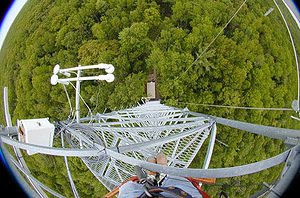For years scientists have hypothesized that a rise in CO2 levels will cause the world’s forests to use water more efficiently, however only recently was this theory proven after Harvard University researchers performed the most complex study of the sort to date. The team of researchers led by research Trevor Keenan and Andrew Richardson actually found the the world’s forests are more efficient than expected.
“This could be considered a beneficial effect of increased atmospheric carbon dioxide,” said Keenan, the first author of the paper. “What’s surprising is we didn’t expect the effect to be this big. A large proportion of the ecosystems in the world are limited by water. They don’t have enough water during the year to reach their maximum growth. If they become more efficient at using water, they should be able to take more carbon out of the atmosphere due to higher growth rates.”
How does CO2 relate to water use? It’s all tied to the fundamental conversion process plants use to transform CO2 taken from the atmosphere to produce O2 called photosynthesis. During photosynthesis plants open tiny pores, called stomata, on their leaves to collect the CO2. Seeing how there’s more CO2 than they’re traditionally used to, compared to other generations where CO2 levels were lower, the plants do not need to open the stomata as wide, or for as long. This means a lower energy usage, translating into less water needed and an increase in efficiency. Farmers, for instance, have known this for a while which is why many greenhouses pump extra CO2 to promote crop growth.
So does this mean that the extra CO2 is actually good for the world’s vegetation? In the short-term yes, however in the long term the chain of events that is triggered by an accelerated rise in CO2 trend, such as the one we’re currently on, will have an overall detrimental effect.
“We’re still very concerned about what rising levels of atmospheric carbon dioxide mean for the planet,” Richardson cautioned. “There is little doubt that as carbon dioxide continues to rise — and last month we just passed a critical milestone, 400 ppm, for the first time in human history — rising global temperatures and changes in rainfall patterns will, in coming decades, have very negative consequences for plant growth in many ecosystems around the world.”

Testing the CO2 fertilizer effect on the world’s forests, however, is much more difficult to assess since you need a heck load of data. Luckily, Harvard has been monitoring forests in northeast United States for 20 years using towers extending above the forest canopy, allows researchers to determine how much carbon dioxide and water are going into or out of the ecosystem. The researchers also employed data from other 300 towers positioned in forests all over the globe, which however haven’t been deployed for nearly as long as those installed by Harvard, but which still can serve valuable data.
When Keenan, Richardson, and their colleagues began to examine those records, they found that forests were storing more carbon and becoming more efficient in how they used water. These findings were not limited to a particular region of the globe, but rather the trend was observed everywhere.
“We went through every possible hypothesis of what could be going on, and ultimately what we were left with is that the only phenomenon that could cause this type of shift in water-use efficiency is rising atmospheric carbon dioxide,” Keenan said.
Next, the researchers plan on improving their assessment by gaining access to data collected from tropical and Arctic regions.
“This larger dataset will help us to better understand the extent of the response we observed,” he said. “That in turn will help us to build better models, and improve predictions of the future of the Earth’s climate. Right now, all the models we have underrepresent this effect by as much as an order of magnitude, so the question is: What are the models not getting? What do they need to incorporate to capture this effect, and how will that affect their projections for climate change?”
The findings were presented in a paper published in the journal Nature.






